Finnair Bundle
How Does Finnair Soar Above the Competition?
In the dynamic world of aviation, understanding a company's commercial strategy is key to predicting its success. Finnair, a leading airline connecting Europe and Asia, has crafted a compelling sales and marketing strategy. This analysis dives deep into Finnair's approach, revealing how it navigates challenges and capitalizes on opportunities.
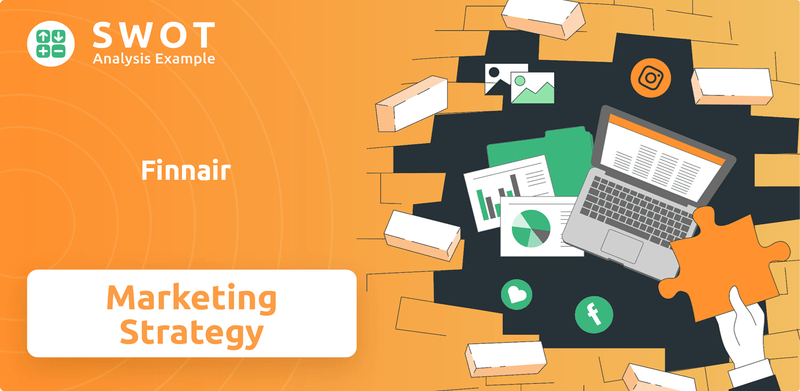
This exploration of Finnair's Finnair SWOT Analysis will uncover the intricacies of its Finnair sales strategy and Finnair marketing strategy. We'll dissect its Finnair marketing plan, examining how the airline generates revenue and targets its market. Furthermore, we'll investigate Finnair's digital marketing strategy, social media campaigns, and customer relationship management to provide a comprehensive view of its commercial success.
How Does Finnair Reach Its Customers?
The sales channels of Finnair are designed to maximize reach and customer accessibility through a blend of digital and traditional methods. The airline focuses on direct sales through its website and mobile app, complemented by partnerships with online travel agencies (OTAs) and global distribution systems (GDS). This multifaceted approach supports the company's growth strategy by ensuring a wide distribution network and a strong direct-to-consumer presence.
Finnair's strategy emphasizes digital channels for direct bookings, ancillary sales, and customer service, reflecting the industry's shift towards digital adoption. This direct-to-consumer (DTC) approach is supported by investments in its website and mobile app, providing a streamlined booking experience. Simultaneously, the airline leverages OTAs and GDS to reach a broader customer base, especially in international markets.
Beyond digital platforms, Finnair maintains a presence through direct sales teams for corporate accounts and travel agencies, offering personalized service. Strategic partnerships, such as those within the Oneworld alliance, extend Finnair's sales reach through codeshare agreements and reciprocal loyalty programs, further enhancing its market share. The airline focuses on omnichannel integration to provide a consistent customer experience across all touchpoints.
Finnair's primary sales strategy relies heavily on its digital platforms. The company website, Finnair.com, is the main e-commerce platform, offering direct bookings and ancillary sales. The Finnair mobile app provides a streamlined booking experience and in-trip services, enhancing customer convenience and engagement.
Finnair partners with OTAs like Expedia and Booking.com to gain market exposure and cater to customers who prefer comparing options. Global Distribution Systems (GDS) such as Amadeus and Sabre are utilized to enable travel agencies worldwide to book Finnair flights. This wholesale distribution model is crucial for reaching a diverse customer base.
Direct sales teams manage corporate accounts and travel agencies, providing personalized service and tailored solutions. Strategic alliances, such as Oneworld, extend Finnair's reach through codeshare agreements and loyalty programs. This approach supports Finnair's revenue generation and customer acquisition.
Finnair focuses on omnichannel integration to ensure a consistent customer experience across all touchpoints. This includes seamless interactions between online and offline channels, enhancing customer satisfaction and loyalty. This strategy is key to Finnair's marketing plan.
Finnair's sales strategy is centered on digital channels, partnerships, and direct sales efforts. The airline emphasizes its website and mobile app for direct bookings, while also leveraging OTAs and GDS for broader market reach. Strategic alliances and omnichannel integration are key to enhancing customer experience and driving revenue.
- Digital Transformation: Investing in digital platforms to enhance the customer experience and streamline booking processes.
- Strategic Partnerships: Collaborating with OTAs, GDS, and alliance partners to expand market reach and offer more options.
- Direct Sales: Maintaining direct sales teams for corporate accounts and travel agencies to provide personalized service.
- Omnichannel Approach: Integrating online and offline channels to ensure a consistent customer experience across all touchpoints.
Finnair SWOT Analysis
- Complete SWOT Breakdown
- Fully Customizable
- Editable in Excel & Word
- Professional Formatting
- Investor-Ready Format
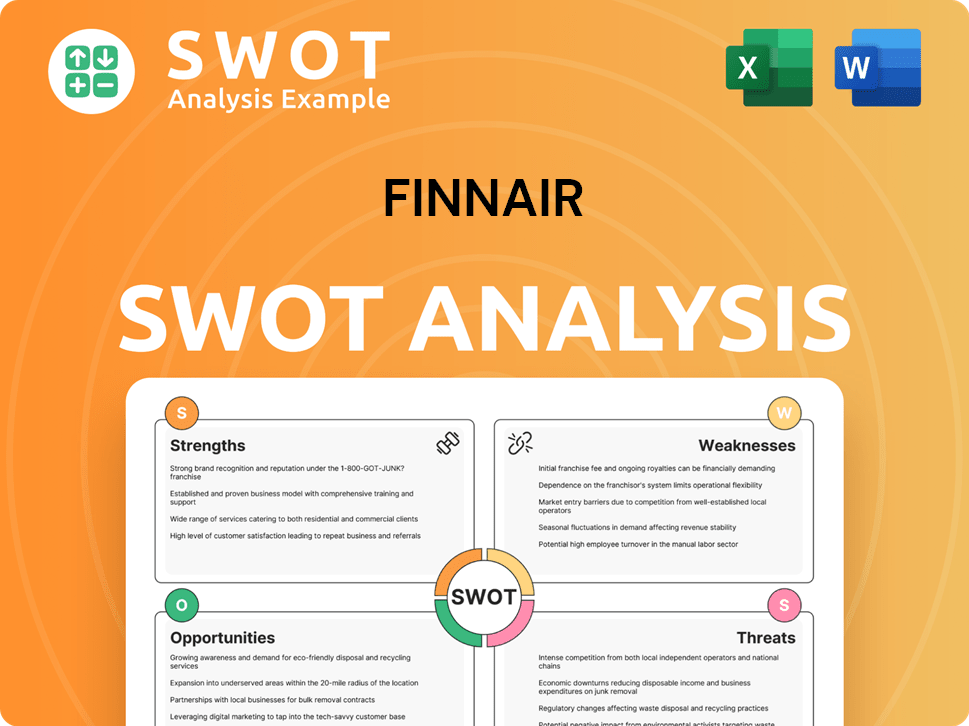
What Marketing Tactics Does Finnair Use?
The marketing tactics employed by Finnair are multifaceted, designed to boost its Finnair sales strategy and strengthen its market presence. This involves a blend of digital innovation and traditional methods to increase brand awareness, generate leads, and drive sales. The airline's approach is data-driven, focusing on customer segmentation and personalization to enhance the effectiveness of its marketing efforts.
Finnair's marketing strategy leverages a variety of digital channels, including content marketing, SEO, and targeted advertising. Social media platforms and email marketing are key components of its customer relationship management (CRM) strategy. Furthermore, Finnair integrates traditional media, such as print advertising and participation in industry events, to reach a broader audience.
The Finnair commercial strategy emphasizes measurable outcomes and a shift towards digital-first approaches. The airline continuously refines its marketing mix, focusing on sustainability communications and initiatives to resonate with environmentally conscious travelers. This comprehensive strategy supports the airline's goals for Finnair revenue generation and expansion.
Finnair's digital marketing strategy is comprehensive, utilizing content marketing, SEO, and targeted advertising. The airline produces engaging content related to travel experiences and sustainability. Paid advertising campaigns are actively used on platforms like Google Ads and social media.
Content marketing is a core element, with Finnair creating content about travel experiences, destinations, and sustainability. SEO ensures high visibility in search results for relevant travel queries. The airline focuses on optimizing content for search engines to improve organic reach.
Social media platforms such as Instagram, Facebook, X (formerly Twitter), and LinkedIn are vital. These platforms are used for real-time customer engagement, brand storytelling, and promotional activities. Social media campaigns are designed to reach a wide audience.
Email marketing is a core component of Finnair's customer relationship management (CRM) strategy. Personalized offers, flight status updates, and loyalty program communications are sent via email. This approach helps in maintaining customer relationships.
Finnair engages in influencer partnerships to reach niche audiences and promote specific routes or services. Collaborations with travel bloggers and social media personalities are common. This strategy expands the airline's reach to targeted demographics.
Select print advertisements in travel magazines and newspapers are still used. Participation in travel fairs and industry events is also part of the strategy. This approach helps in direct engagement with potential customers and partners.
Finnair's marketing plan uses customer segmentation to tailor messages based on travel history and preferences. Personalization is key, with dynamic content delivery on its website and in email communications. The airline uses analytics to track campaign performance and customer behavior.
- Market Segmentation: Finnair segments its Finnair target market based on demographics, travel patterns, and preferences. This allows for targeted marketing messages.
- Personalization: Dynamic content on the website and in emails provides personalized experiences. This includes tailored offers and flight information.
- Analytics and Measurement: Analytics tools track campaign performance, website traffic, and customer behavior. This informs future marketing strategies.
- Sustainability Initiatives: Finnair promotes its efforts to reduce emissions and offers carbon offsetting options. This resonates with environmentally conscious travelers.
- Partnerships and Collaborations: The airline engages in partnerships with various entities to expand its reach. This includes collaborations with travel agencies and other airlines. Read more about the Target Market of Finnair.
Finnair PESTLE Analysis
- Covers All 6 PESTLE Categories
- No Research Needed – Save Hours of Work
- Built by Experts, Trusted by Consultants
- Instant Download, Ready to Use
- 100% Editable, Fully Customizable
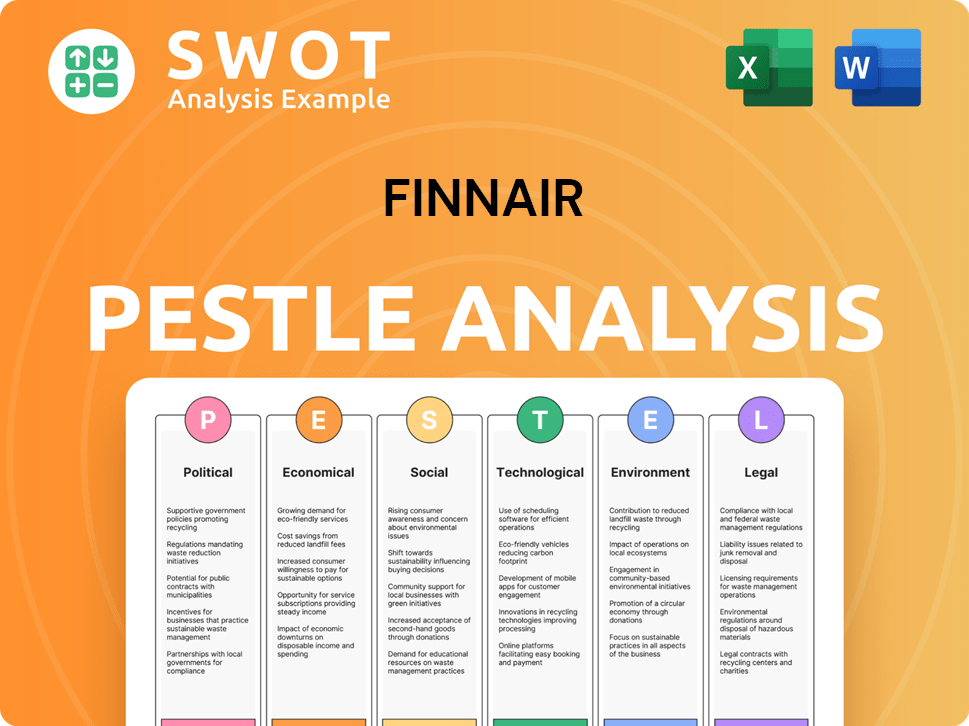
How Is Finnair Positioned in the Market?
The brand positioning of Finnair centers on its Nordic heritage, setting it apart through a blend of reliability, design, and a strong focus on customer well-being. The core message emphasizes a smooth, comfortable, and efficient travel experience, particularly highlighting its role as the fastest and most convenient connection between Europe and Asia. This strategy is crucial for its Finnair sales strategy.
Visually, Finnair is recognized by its blue and white livery, symbolizing purity and the Finnish landscape, alongside minimalist design elements across all touchpoints. The tone of voice is professional, calm, and approachable, reflecting Nordic values of understated elegance and efficiency. This approach is integral to its Finnair marketing strategy and overall Finnair commercial strategy.
Finnair targets business and leisure travelers seeking efficient long-haul connections. Its Helsinki hub offers shorter flight times between Europe and Asia, a key advantage for time-sensitive travelers. The airline also emphasizes sustainability, communicating efforts to reduce environmental impact. This focus is part of its Finnair marketing plan.
The Helsinki hub provides shorter flight times between Europe and Asia, a significant benefit for travelers. This strategic location is a key component of Finnair's competitive advantage. This is a crucial element of Finnair revenue generation.
Finnair actively communicates its efforts to reduce environmental impact. This includes fleet modernization, sustainable aviation fuel (SAF) initiatives, and carbon offsetting programs. This resonates with environmentally conscious consumers, a key part of their Finnair target market.
Finnair's brand identity is consistently maintained across all channels, from in-flight service to digital communications. This ensures a cohesive and recognizable brand experience, supporting its Finnair's digital marketing strategy. The airline actively monitors consumer sentiment and adapts its messaging to address competitive threats.
- Visual Identity: Distinctive blue and white livery, minimalist design.
- Tone of Voice: Professional, calm, and approachable.
- Customer Experience: Emphasizes punctuality and high-quality service.
- Core Message: Smooth, comfortable, and efficient travel.
For deeper insights into the company's financial structure, consider exploring the ownership details via Owners & Shareholders of Finnair. This can provide a clearer understanding of the company's strategic direction and financial health.
Finnair Business Model Canvas
- Complete 9-Block Business Model Canvas
- Effortlessly Communicate Your Business Strategy
- Investor-Ready BMC Format
- 100% Editable and Customizable
- Clear and Structured Layout
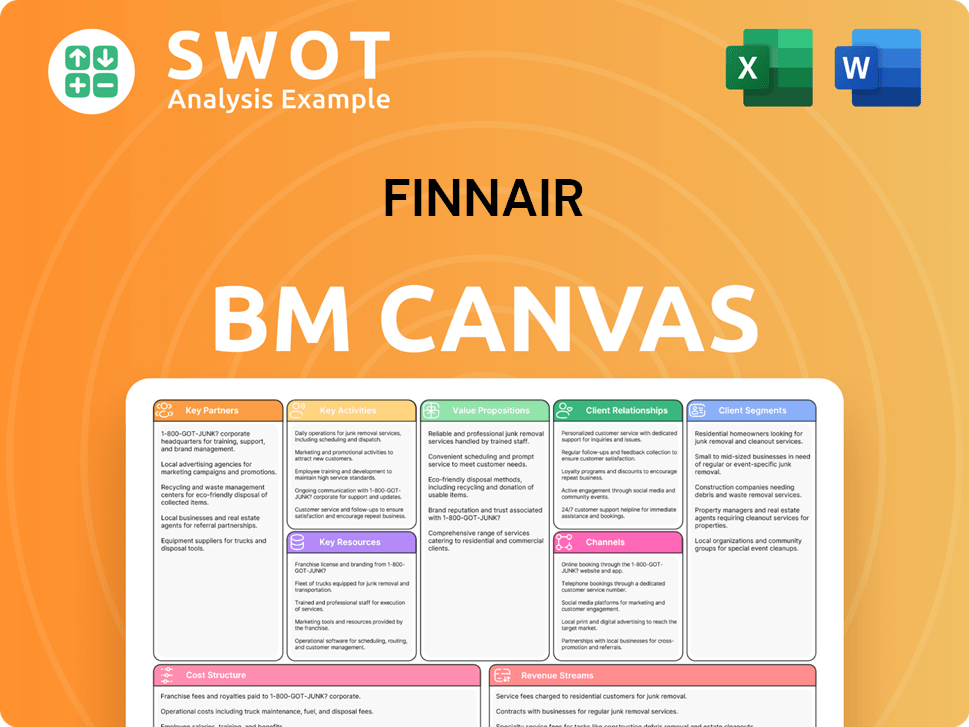
What Are Finnair’s Most Notable Campaigns?
The Finnair sales strategy and marketing efforts have been crucial in navigating the post-pandemic recovery and achieving growth. Key campaigns have focused on sustainability, route expansion, and strategic partnerships. These initiatives have been instrumental in attracting customers and reinforcing the airline's brand in a competitive market.
One of the primary goals of the Finnair marketing strategy is to attract environmentally conscious travelers. Digital channels, including social media, the company website, and targeted email campaigns, are used to promote sustainability initiatives. These initiatives often feature visuals of modern aircraft and messaging around SAF usage and carbon offsetting. This approach aims to enhance the airline's image as a responsible carrier and influence booking decisions.
Another core element of the Finnair commercial strategy involves promoting its expanded network and new routes. These campaigns use destination-specific content, showcasing cultural and leisure attractions, and are promoted through paid digital advertising and collaborations with destination marketing organizations. This strategy is particularly important for routes to Asia, a key focus for the airline.
These campaigns highlight Finnair's commitment to reducing its environmental footprint, aiming to attract eco-conscious travelers. Digital channels, such as social media and the company website, are used to promote these initiatives. The campaigns often feature visuals of modern aircraft and messaging around SAF usage and carbon offsetting.
Promoting new routes and destinations is a key focus, with campaigns using destination-specific content to showcase attractions. Digital advertising, travel publications, and collaborations with destination marketing organizations are key channels. Campaigns targeting renewed Asian destinations have been crucial for recovery.
Finnair collaborates with tourism boards and loyalty program partners to enhance brand visibility. The airline leverages partnerships within the Oneworld alliance for joint marketing efforts. These collaborations are essential for expanding reach and credibility.
Demonstrating agility and adaptability in marketing strategies is vital, especially in response to geopolitical events and travel advisories. Transparency and clear communication during challenging times, focusing on passenger safety and flexibility, are critical.
While specific real-time metrics for 2024-2025 are not publicly disclosed, the impact of these campaigns is evident in the airline's performance. The airline’s recovery in 2023 showed a significant increase in passenger numbers and revenue compared to the previous year, demonstrating the effectiveness of these campaigns in rebuilding its network and attracting travelers.
- Focus on sustainability initiatives to attract environmentally conscious travelers.
- Promotion of expanded network and new routes, especially to Asia.
- Collaborations with tourism boards and Oneworld alliance partners.
- Emphasis on agility and transparent communication during crises.
Finnair Porter's Five Forces Analysis
- Covers All 5 Competitive Forces in Detail
- Structured for Consultants, Students, and Founders
- 100% Editable in Microsoft Word & Excel
- Instant Digital Download – Use Immediately
- Compatible with Mac & PC – Fully Unlocked
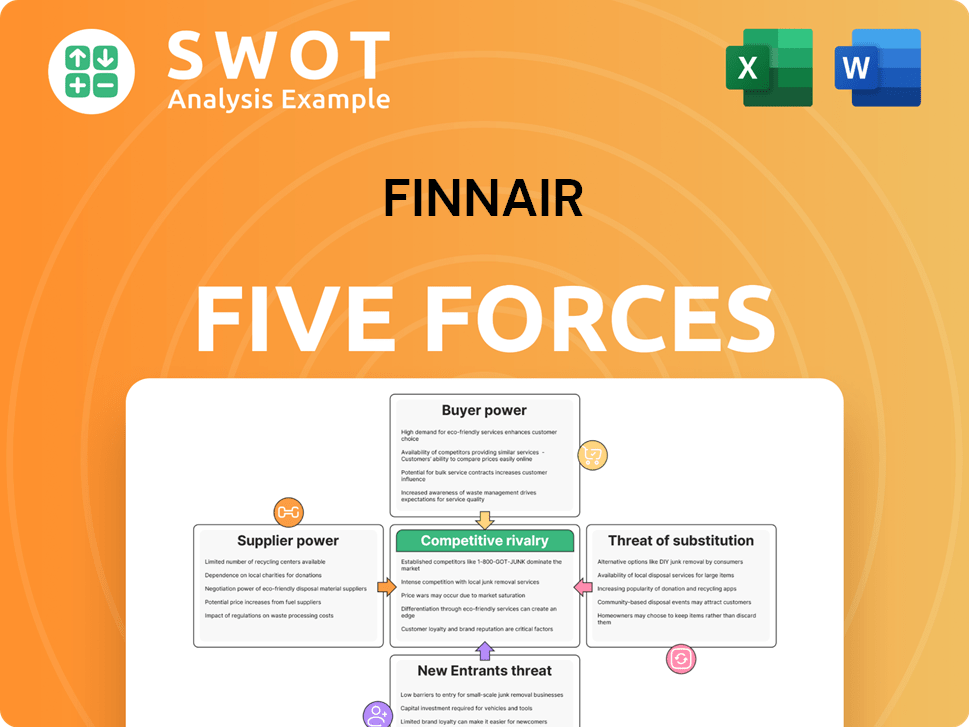
Related Blogs
- What are Mission Vision & Core Values of Finnair Company?
- What is Competitive Landscape of Finnair Company?
- What is Growth Strategy and Future Prospects of Finnair Company?
- How Does Finnair Company Work?
- What is Brief History of Finnair Company?
- Who Owns Finnair Company?
- What is Customer Demographics and Target Market of Finnair Company?
Disclaimer
All information, articles, and product details provided on this website are for general informational and educational purposes only. We do not claim any ownership over, nor do we intend to infringe upon, any trademarks, copyrights, logos, brand names, or other intellectual property mentioned or depicted on this site. Such intellectual property remains the property of its respective owners, and any references here are made solely for identification or informational purposes, without implying any affiliation, endorsement, or partnership.
We make no representations or warranties, express or implied, regarding the accuracy, completeness, or suitability of any content or products presented. Nothing on this website should be construed as legal, tax, investment, financial, medical, or other professional advice. In addition, no part of this site—including articles or product references—constitutes a solicitation, recommendation, endorsement, advertisement, or offer to buy or sell any securities, franchises, or other financial instruments, particularly in jurisdictions where such activity would be unlawful.
All content is of a general nature and may not address the specific circumstances of any individual or entity. It is not a substitute for professional advice or services. Any actions you take based on the information provided here are strictly at your own risk. You accept full responsibility for any decisions or outcomes arising from your use of this website and agree to release us from any liability in connection with your use of, or reliance upon, the content or products found herein.